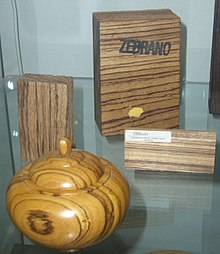Microberlinia
This article was based on formal or substantive deficiencies in the quality assurance biology in the section "plants" entered for improvement. This is done in order to bring the quality of the biology articles to an acceptable level. Please help improve this article! Articles that are not significantly improved can be deleted if necessary.
Read the more detailed information in the minimum requirements for biology articles .
| Microberlinia | ||||||||||||
|---|---|---|---|---|---|---|---|---|---|---|---|---|

Zebrawood |
||||||||||||
| Systematics | ||||||||||||
|
||||||||||||
| Scientific name | ||||||||||||
| Microberlinia | ||||||||||||
| A.Chev. |
Microberlinia is a genus of plants in the subfamily of the carob family (Caesalpinioideae) within the legume family (Fabaceae). The only two species are common in tropical western central Africa. Both types provide tropical precious wood , which istradedunder the names Zebrano or Zingana .
description
Microberlinia species grow as trees that can reach heights of up to 40–45 meters. The trunk diameter reaches 75-150 centimeters. Buttress roots may be present on the trunk.
The pair of pinnate leaves, with sessile and thick, leathery leaves , are arranged alternately. The stipules are accumulating.
Terminal or axillary grapes with reddish and fine-haired rachis are formed, the bracts are sloping. The zygomorphic , short-stalked and five-fold flowers with a double perimeter are hermaphroditic. They are white and underlaid with 2 large bracts. There are 10 stamens , one free and 9 fused. The more or less stalked ovary is on top.
Up to 18 centimeters long, pointed, beaked legumes are formed that contain 3–6 seeds. The flat seeds are blackish.
Systematics and distribution
The genus Microberlinia was established in 1946 by Auguste Jean Baptiste Chevalier in Revue International de Botanique Appliquee et d'Agriculture Tropicale , Volume 26, p. 588. The genus name Microberlinia is made up of micro for small and Berlinia , a closely related and similar-looking genus with larger leaves.
The genus Microberlinia belongs to the tribe Detarieae in the subfamily Caesalpinioideae within the Fabaceae family . The position of Microberlinia within the African Macrolobieae - clade 2001 was unclear.
The two Microberlinia species grow in the tropical rainforests of Central Africa, one of which is only found in Cameroon and the other is found in Gabon and the Republic of the Congo .
The genus Microberlinia contains only 2 species:
- Microberlinia bisulcata A. Chev. : It occurs in Cameroon only in the southwestern part and around Mt. Cameroon. It thrives in lowland rainforest, mostly on sandy soils in the plains. It was in 2000 in the endangered species red list of the IUCN as "Critically Endangered" = "threatened with extinction" rated; up-to-date monitoring is required.
- Microberlinia brazzavillensis A. Chev. : It occurs in Gabon and in adjacent areas of the Republic of the Congo . The occurrence in Cameroon is considered unsafe. It thrives in coastal forests. The locations are small and the individual specimens are often far apart with less than one specimen per km². It was in 1998 in the endangered species red list of the IUCN "rated at risk" as "Vulnerable"; up-to-date monitoring is required.
use
Wood properties
The wood is striped yellowish white with deep brown veins (" zebra wood ") and gray sapwood . It is quite hard, dense and brittle and has an unpleasant odor of its own. It has the alternating twist that is typical of some tropical woods .
use
The zebrawood is for the construction of guitars -Böden- and frames used as well as veneer in the interiors of luxury - automobiles . Zebrano wood is also used in high-quality furniture construction as a veneer and also in solid construction. It is particularly suitable for designing solid wood tables and for building small residential objects.
The unusual pattern of the wood made it very popular. But the great demand for this tropical wood is also the greatest threat to both microberlinia species. The two types of Microberlinia are not protected according to CITES rules.
Individual evidence
- ↑ a b Entry in commercial timbers from DELTA - version from June 2009.
- ↑ a b c d e Search for "Microberlinia" in the IUCN Red List of Threatened Species 2014.3.
- ↑ Microberlinia at Tropicos.org. Missouri Botanical Garden, St. Louis, accessed April 27, 2015.
- ↑ a b c Data sheet from Legumes of the World at Royal Botanical Gardens Kew. ( Memento of the original from September 21, 2015 in the Internet Archive ) Info: The archive link was inserted automatically and has not yet been checked. Please check the original and archive link according to the instructions and then remove this notice. Last accessed on April 27, 2015
- ↑ a b c d e Microberlinia in the Germplasm Resources Information Network (GRIN), USDA , ARS , National Genetic Resources Program. National Germplasm Resources Laboratory, Beltsville, Maryland. Retrieved April 27, 2015.
- ↑ a b c Microberlinia species on the LegumeWeb of the International Legume Database & Information Service (ILDIS) . (English)
